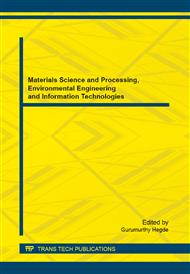[1]
Lijuan Zhang, Comparison of sewage source heat pump system technology and direct and indirect system [D], Harbin Harbin Institute of Technology, (2008).
Google Scholar
[2]
Nengzhao Jiang, Daoping Jiang, Water, ground source, water loop heat pump technology and Application [J]. Machinery Industry Press, 20073.
Google Scholar
[3]
Ronghuan Wu, Chenghu Zhang, Dexing Sun. Comparative study of city sewage and other sources of heat. [J], HVAC, 2006, 1: 46~47.
Google Scholar
[4]
Mei Dou etc. Heat exchanger built-in spring pulse flow anti f ouling experiments [J]. Journal of Chemical Engineering, 2010, 24 (5): 893~896.
Google Scholar
[5]
Xingquan Chu, Long pipelines ultrasonic Anti-fouling / scaling device, China patent, 201020267367 [P]. 2010~07~12.
Google Scholar
[6]
Zhao Shen, Yiqiang Jiang, etc. Numerical simulation of automatic decontamination type sewage water - water heat exchanger, [J], civil and environmental engineering, 2011, 33 (3): 107~111.
Google Scholar
[7]
NORIO A. Evaluation of energy use in district heating and cooling plant using sewage and one using air as heat source [J]. Joural of the Japan Institute of Energy, 2000(5): 446~454.
DOI: 10.3775/jie.79.446
Google Scholar
[8]
YOGHII T. Technology for utilizing unused low temperature difference energy [J]. Joural of the Japan Institute of Energy, 2001(8): 696~706.
Google Scholar
[9]
Yang Shanrang, Xu Zhiming, Sun Lingfang. Fouling and Prevention in Heat Transfer Equipment[M]. 2nded. Beijing: Science Press, 2004: 8.
Google Scholar
[10]
Pollet Bet al. Ultrasonic Sonochemistry, 2000, 7: 69.
Google Scholar
[11]
Nishida I. Precipitation of calcium carbonate by ultrasonic irradiation [J]. Ultrasonics Sonochemistry, 2004, 11(6): 423~428.
DOI: 10.1016/j.ultsonch.2003.09.003
Google Scholar
[12]
Dingwei Zhou, Xuegong Hu and Dengying Liu. Local convective heat transfer from a horizontal tube in an acoustic cavitation field. Journal of Thermal Science, 2004, 13 (4): 338~343.
DOI: 10.1007/s11630-004-0052-1
Google Scholar
[13]
Zhimei Ma, Research progress of ultrasonic antiscaling and descaling technology, Chinese and foreign energy [J], 2008, 13: 92~96.
Google Scholar
[14]
Shoulei Gao, Qijie Zhai, etc. The development and application of ultrasonic in solidification process of metals. Materials review [J] . 200, 16: 5~ 6.
Google Scholar
[15]
Runyang Mo, Shuyu Lin, etc. Research progress and methods of ultrasonic cavitation [J], Application of acoustic, 2009, 28(5): 389~394.
Google Scholar
[16]
Zhenfang Shi, Numerical simulation study on Optimization of acoustic cavitation [D], The paper of Shaanxi Normal University Master, (2009).
Google Scholar


